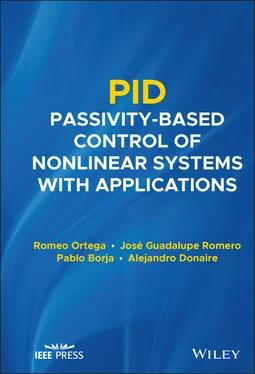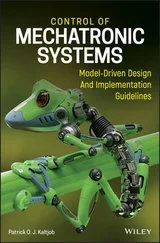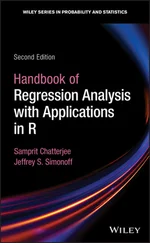It is widely recognized that proportional‐integral‐derivative (PID) control offers the simplest and yet most efficient solution to many real‐world control problems. It is said to be a universal controller in the sense that the integral action takes care of the past, the proportional one of the present, and the derivative term has a predictive effect. Since the invention of PID control in 1910, the popularity of PID control has grown tremendously (Ang et al., 2005; Åstrom and Hägglund, 1995, 2006; Samad, 2017).
It is interesting to quote a 2018 report of Karl Åstrom (Åstrom, 2018) where he points out the following:
In spite of the predictions that other control techniques, e.g. model predictive control (MPC), will make, the PID obsolete, more than 90% of industrial controllers are still implemented based around PID algorithms.
In a report of Bill Bialkowski of the Canadian consulting company Entech, it is indicated that out of 3000–5000 control loops in the paper mill industry, 97% use proportional‐derivative (PI) and the remaining 3% are MPC, adaptive, etc.
In the same report it is indicated that, out of the 50% of the PIDs that do not work well, 30% are due to bad tuning.
Indeed, it is very well known that PID controllers yield, in general, a satisfactory performance provided they are well tuned . The need to fulfill this requirement has been the major driving force of the research on PID control, with the vast majority of the reports related to the development of various PID tuning techniques, which are customarily based on a linear approximation of the plant around a fixed operating point (or a given trajectory). When the range of operation of the system is large, the linear approximation is invalidated and the procedure to tune the gains of PID regulators is a challenging task. Although gain scheduling, auto tuning, and adaptation provide some help to overcome this problem, they suffer from well‐documented drawbacks that include being time‐consuming and fragility of the design. The interested reader is referred to Ang et al. (2005) for a recent, detailed account of the various trends and topics pertaining to PID tuning.
The present book is devoted to the study of PID passivity‐based control (PBC), which provides a solution to the tuning problem of PID control of nonlinear systems . The underlying principle for the operation of PID‐PBC is, as the name indicates, the property of passivity , which is a fundamental property of dynamical systems. One of the foundational results of control theory is the passivity theorem (Desoer and Vidyasagar, 2009; Khalil, 2002; van der Schaft, 2016), which states that the feedback interconnection of two passive systems ensures convergence of the output to zero and stability (in the  sense) of the closed‐loop. On the other hand, it is well‐known (van der Schaft, 2016) that PID controllers are (output strictly) passive systems – for all positive PID gains. Therefore, wrapping the PID around a passive output yields a stable system for all PID gains. Clearly, this situation simplifies the gain‐tuning task, since the designer is left with the only task of selecting, among all positive gains, those that ensure the best transient performance .
sense) of the closed‐loop. On the other hand, it is well‐known (van der Schaft, 2016) that PID controllers are (output strictly) passive systems – for all positive PID gains. Therefore, wrapping the PID around a passive output yields a stable system for all PID gains. Clearly, this situation simplifies the gain‐tuning task, since the designer is left with the only task of selecting, among all positive gains, those that ensure the best transient performance .
PID‐PBCs have been successfully applied to a wide class of physical systems, see e.g. Aranovskiy et al. (2016), Castaños et al. (2009), Cisneros et al. (2015, 2016), De Persis and Monshizadeh (2017), Hernández‐Gómez et al. (2010), Meza et al. (2012), Romero et al. (2018), Sanders and Verghese (1992), and Talj et al. (2010). However, their application has mainly been restricted to academic circles. It is the authors' belief that PID‐PBCs have an enormous potential in engineering practice and should be promoted among practitioners. The main objective of the book is then to give prospective designers of PID‐PBCs the tools to successfully use this technique in their practical applications. Toward this end, we provide a basic introduction to the theoretical foundations of the topic, keeping the mathematical level at the strict minimum necessary to cover the material in a rigorous way, but at the same time to make it accessible to an audience more interested in its practical application. To fulfill this objective, we have skipped technically involved theoretical proofs – referring the interested reader to their adequate source – and we have included a large number of practical examples.
We are aware that aiming at penetrating current engineering practice is a very challenging task. It is our strong belief that combining the unquestionable dominance of PIDs in applications with the fundamental property of passivity, which in the case of physical systems captures the universal feature of energy conservation, yields an unbeatable argument to justify its application.
1 K. H. Ang, G. Chong, and Y. Li. PID control system analysis, design and technology. IEEE Transactions on Control Systems Technology, 13(4): 559–576, 2005.
2 S. Aranovskiy, R. Ortega, and R. Cisneros. A robust PI passivity‐based control of nonlinear systems and its application to temperature regulation. International Journal of Robust and Nonlinear Control, 26(10): 2216–2231, 2016.
3 K. J. Åstrom. Advances in PID control. In XXXIX Jornadas de Automatica, Badajoz, Spain, 2018.
4 K. J. Åstrom and T. Hägglund. PID Controllers: Theory, Design, and Tuning. 2nd edition. Instrument Society of America, 1995.
5 K. J. Åstrom and T. Hägglund. Advanced PID control. ISA‐The Instrumentation, Systems, and Automation Society, Research Triangle Park, NC 27709, 2006.
6 F. Castaños, B. Jayawardhana, R. Ortega, and E. García‐Canseco. Proportional plus integral control for set point regulation of a class of nonlinear RLC circuits. Circuits, Systems and Signal Processing, 28(4): 609–623, 2009.
7 R. Cisneros, M. Pirro, G. Bergna‐Díaz, R. Ortega, G. Ippoliti, and M. Molinas. Global tracking passivity‐based PI control of bilinear systems and its application to the boost and modular multilevel converters. Control Engineering Practice, 43(10): 109–119, 2015.
8 R. Cisneros, R. Gao, R. Ortega, and I. Husain. PI passivity‐based control for maximum power extraction of a wind energy system with guaranteed stability properties. International Journal of Emerging Electric Power Systems, 17(5): 567–573, 2016.
9 C. De Persis and N. Monshizadeh. Bregman storage functions for microgrid control. IEEE Transactions on Automatic Control, 63(1): 53–68, 2017.
10 C. A. Desoer and M. Vidyasagar. Feedback Systems: Input‐Output Properties. Academic Press, New York, 2009.
11 M. Hernández-Gómez, R. Ortega, F. Lamnabhi‐Lagarrigue, and G. Escobar. Adaptive PI stabilization of switched power converters. IEEE Transactions on Control Systems Technology, 18(3): 688–698, 2010.
12 H. Khalil. Nonlinear Systems. Prentice‐Hall, Upper Saddle River, NJ, 2002.
13 C. Meza, D. Biel, D. Jeltsema, and J. M. A. Scherpen. Lyapunov‐based control scheme for single‐phase grid‐connected PV central inverters. IEEE Transactions on Control Systems Technology, 20(2): 520–529, 2012.
14 J. G. Romero, A. Donaire, R. Ortega, and P. Borja. Global stabilisation of underactuated mechanical systems via PID passivity‐based control. Automatica, 96(10): 178–185, 2018.
15 T. Samad. A survey on industry impact and challenges thereof. IEEE Control Systems Magazine, 37(1): 17–18, 2017.
16 S. R. Sanders and G. C. Verghese. Lyapunov‐based control for switched power converters. IEEE Transactions on Power Electronics, 7(1): 17–24, 1992.
Читать дальше

 sense) of the closed‐loop. On the other hand, it is well‐known (van der Schaft, 2016) that PID controllers are (output strictly) passive systems – for all positive PID gains. Therefore, wrapping the PID around a passive output yields a stable system for all PID gains. Clearly, this situation simplifies the gain‐tuning task, since the designer is left with the only task of selecting, among all positive gains, those that ensure the best transient performance .
sense) of the closed‐loop. On the other hand, it is well‐known (van der Schaft, 2016) that PID controllers are (output strictly) passive systems – for all positive PID gains. Therefore, wrapping the PID around a passive output yields a stable system for all PID gains. Clearly, this situation simplifies the gain‐tuning task, since the designer is left with the only task of selecting, among all positive gains, those that ensure the best transient performance .










